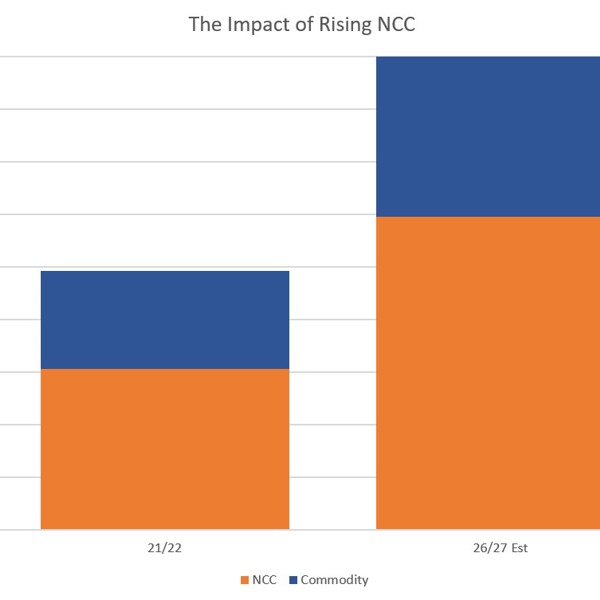Introduction
Over recent years, non-commodity costs, the charges that sit along the wholesale price of energy, have risen sharply. WME analysis shows that non-commodity prices have doubled in the last five years, and the trend is set to continue.

From April 2026, the non-energy elements for electricity are forecast to rise by as much as 27%*, which means from April 26, they could make up as much as 70% of a total electricity invoice. Gas non-energy elements are to rise by around 18%* and will account for as much as 35% of overall gas costs.
The chart below shows actual change between 2021/22 and 2026/27.
*Actual increases will vary based on location
What are non-commodity costs?
Non-commodity costs, (sometimes referred to as non-energy costs or third-party charges) cover the essential infrastructure and policy charges required to deliver electricity. They include:
- Network charges (to maintain and upgrade the grid)
- Government policy costs (supporting decarbonisation, renewable energy, and security of supply)
- Other industry costs (such as settlement systems and regulation)
These charges are set nationally and collected through supplier invoices. They apply to all suppliers and cannot be “shopped around.”
The big three changes impacting electricity prices from April 2026
While many elements make up non-commodity costs, the three with the biggest increases from next year, are set out below.
- Transmission Use of System (TUoS) – the cost of transporting electricity across the national network. This is set to increase significantly as National Grid invests in strengthening and expanding infrastructure to support the transition to renewables.
This charge varies significantly between geographic locations and as a result, can mean material differences in the charges depending on location.
- Nuclear Regulated Asset Base (RAB) – a charge to help fund the development of new nuclear power stations such as Sizewell C. This mechanism shifts some of the upfront costs to consumers during construction, reducing the long-term financing costs.
- Energy Intensive Industries – Non-Commodity Cost Scheme (EII NCCS) – a policy decision to exempt certain heavy industries from some charges. This exemption means the costs are redistributed, with other consumers (including the public sector) picking up the difference.
The big three changes impacting gas prices from April 2026
While electricity is seeing the biggest increases, gas users will also face notable non-commodity cost increases from April 2026. Two charges in particular are forecast to rise significantly:
- Local Distribution Zone (LDZ) Charges – these cover the cost of transporting gas through the regional distribution networks to end users. These charges vary by region and reflect higher infrastructure and maintenance costs.
- Unidentified Gas (UIG) – this relates to gas that is used but not accurately allocated to a specific meter, often due to data estimation or timing differences. The costs of this “lost” gas are shared across all users, and the UIG rate is projected to rise by approximately 21%.
WME’s commitment to helping customers amongst rising non-commodity costs
While non-commodity costs are, to a point, unavoidable, WME’s fully managed service ensures our customers are kept informed, and that the charges are correct.
WME commit:
- To continue validating each of the non-commodity costs, ensuring the charges levied are correct.
- To continue to review capacity levels and advise where banding can be reduced to minimise the charges levied.
- To continue raising awareness regarding the challenges and pressures presented by increasing non-commodity costs for all our public sector customers, while advocating to the Government and Ofgem where appropriate.
- To continue to provide quality and accurate budget forecast information, helping customers plan ahead, budget effectively and manage the impact of rising non-energy costs.
- To continue to deliver our risk managed energy procurement with an aim of keeping energy costs as low as possible, offsetting where we can, further rises is non-commodity costs.
- To look for innovative solutions to help minimise non-commodity costs.
- To continue to support the public sector to reduce their energy consumption and increase self-generation as a way of mitigating high non-commodity costs.




